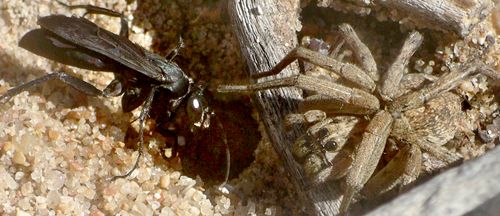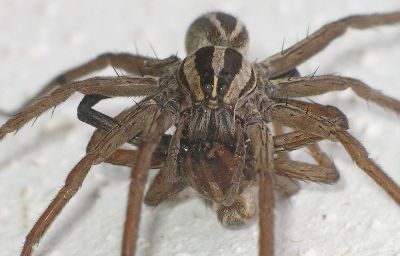
A spider wasp digs its nest burrow while its paralyzed prey waits helplessly.
It is safe to say that a majority of people find spiders rather repulsive. You don't have to search too hard for reasons. Having more legs and eyes than we do is a good start, and being dark and hairy helps too. Follow that up with a penchant for creeping around in shadowy places, sometimes remaining stock still before darting unpredictably in various directions, and having the unfortunate habit of surprising us with their unexpected presence on walls, our bathtub or our foot, and you've pretty much described a living nightmare.
The stereotype I just described might at first sound like any spider, but in fact is more specific. A good number of spiders spend their entire lives unseen beneath rocks, curled up in leaves or dangling benignly in a silken web. One kind of spider, though, is so well known for its wandering hunting style that it is named after a mammal with similar negative connotations: the wolf spider. Members of the family Lycosidae sort of epitomize spiders as a symbol reflecting scariness, horror movies and Halloween. While tarantulas are larger, wolf spiders are more common and widespread. There are many species, and they range in adult size from miniscule to disturbingly large. Almost all wolf spiders spend most of their time walking around on the ground looking for food. Exceptions include the burrowing wolf spiders, which live in holes in the ground and a few that make a silk tube for their home.
All spiders are hunters, and it is understandable to think of wolf spiders as top predators of their arthropod world. In spite of being big compared to other spiders, even the largest lycosids are not a threat to our humanly overwhelming size advantage. It is tempting to estimate the size of spiders by their legs,
 A spider wasp digs its nest burrow while its paralyzed prey waits helplessly. |
For all their ferocious appearances, wolf spiders live in a state of constant vigilance for danger. Their defenses begin, and usually end, with running away. Anything bigger than them, and there are a lot of animals that fill the bill, is a potential threat. Birds and small mammals from shrews to coyotes eat them, as do lizards and toads. Becoming a meal and being squished by a foot produce the same results for a spider, so it is little wonder that they flee our presence.
While vertebrates are definitely a hazard, there are other dangers that wolf spiders face, and they don't have to do with a size advantage. Many kinds of wasps hunt prey for their larvae. The typical scenario involves a solitary female wasp locating an appropriate target, paralyzing it with a sting, dragging it into a hole, laying an egg on the unfortunate victim, and sealing the nest entrance. The wasp larva hatches, feeds on the conveniently fresh flesh of the immobilized spider, then pupates and eventually leaves the nest as an adult. Variation occurs with the number of spiders needed for each baby wasp to make it maturity. Mud Daubers stock their nests with many small spiders that will nourish a single wasp, but most other wasps select a single spider that is big enough to provide the sustenance for each baby's development. There is a whole family, Pompilidae, that is known as the spider wasps, and they all follow this model. The biggest of this group is the Tarantula Hawk, famous for the epic battles between our largest North American spider and its gargantuan predator. There are, however, many kinds of spider wasps and they range in size down to those small enough to complete development by feeding on a single jumping spider. A fair number of pompilids
 When courtship doesn't work out as it should: female wolf spider eating male. |
Spiders are general predators and will subdue and eat any other animal they can. They do not make distinctions between insects, other spiders or even their own species. Normally, a spider's instinct to keep away from dangerous animals includes members of its own species. The big exception involves males that must approach females in order to mate. If every female spider responded in the usual predator way, there would be no more spiders at all, but evolution has favored the male who uses behaviors to convince a female that he is not a menu item. Courtship amongst spiders can include giving visual or tactile cues and depends on the male reading the female's responses correctly. While some spiders have a large size difference between the two sexes, wolf spider males and females are about the same size. If all goes well, the male approaches the female, convinces her to cooperate, and they mate. He then goes off to live out the rest of his short, but successful, life, while she bears his offspring. As with any delicate operation, if anything goes wrong, such as the female feeling particularly unreceptive, confused, or perhaps hungry, there is the possibility of the male becoming her next meal.
One agent of spider death is particularly revolting to our mammalian sensibilities. It is so much so that this type of species interaction has become well known through the movie "Alien" where a malevolent parasitic species bursts out of a man's chest. Oddly, he never even realized up to that point that there was something that large living within him.
 A mermithid nematode worm emerging from a spider's abdomen. |
But, putting effectively entertaining science fiction tales aside, the arthropod realm is awash in parasitoids that inhabit a host's body, feeding on it, altering it, and even changing its behavior. The instance I saw recently, and which prompted me to write about this particular topic, involved a hapless wolf spider that was on a concrete patio floor. When I saw the spider, the light was dim and it appeared that something was hanging at the back of the spider's abdomen. I surmised that the arachnid might have been accidentally stepped on and therefore badly wounded, but when I approached it, the spider dashed several feet in a very uninjured sort of way. Unable to make out just what was wrong with the spider, I took some photos. Through the magic of enlarging a digital image on a computer screen, the explanation became clear. The spider was the host for a kind of nematode worm in the family Mermithidae. These worms are similar in many ways to horsehair worms but are classified in a different phylum. Part of the worm's life cycle includes living within the spider's abdomen for awhile. After feeding inside the spider, and taking up all the room within its body, the worm emerges and the spider dies.
The scary characteristics we assign to the wandering hunters known as wolf spiders are usually blown out of proportion to the actuality of their existence. Just like the circumstances of any animal within an ecosystem can change for better or worse, a slight shift of fortunes can mean a predator sometimes becomes the victim. We humans are quite lucky to not only have a minimum of such mortal dangers in our lives but to also be able to appreciate the innumerable intricacies occurring between all the other species with which we share this planet.